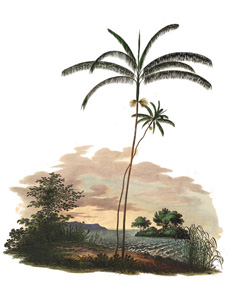
Acai, Assai Palm, Acai Palm
Latin Name: Euterpe oleracea
USDA Hardiness: 10-12
Native Range: SOUTHERN AMERICA: Brazil North, Brazil Northeast, Colombia, Ecuador, French Guiana, Guyana, Suriname, Trinidad-Tobago, Venezuela,
Edibility Rating: 5 / 5
Medicinal Rating: 2 / 5
Region:
Family:
Plant Type:
Medicinal Uses
Edible Uses
Edible Parts: Apical bud Fruit Leaves Oil Seed | Edible Uses: Drink Oil TeaFruit - raw or cooked. A thin, fibrous, fleshy pulp with little flavour[ 416 ]. A very nutritious fruit, rich in antioxidants, it is often used to make a drink that is very popular in the Amazon region of Brazil[ 46 , 297 ]. The juice is extracted from the small round fruit by soaking the seeds in water to soften the thin outer shell and then squeezing and straining them to produce a very tasty, dense purple liquid[ 314 ]. This liquid is served ice cold with (or sometimes without) sugar and tapioca flour. It is a nourishing and refreshing drink that is also used to produce ice cream, liquor, mousses and sweets in general[ 314 ]. The juice is also added to various foods such as tapioca, cassava and porridge[ 301 ]. The purplish-black fruit is about 15 - 25mm in diameter, and is borne in huge clusters of up to 1,000 fruits[ 297 , 377 ]. Leaves - cooked[ 297 ]. Crunchy, with a sweet flavour[ 297 ]. Said to resemble artichokes (Cynara scolymus)[ 46 , 301 ]. The unexpanded leaves and bud from the crown of the plant are used[ 297 ]. Harvesting these leaves eventually kills the stem of the plant because it is unable to produce side shoots[ 297 ], although the plant can produce new stems from its base[ 314 ]. An edible oil is obtained from the seed[ 301 ].
Cultivation
A plant of the moist to wet tropics, where it is found at elevations up to 3,000 metres. It grows best in areas where annual daytime temperatures are within the range 22 - 28°c, but can tolerate 16 - 32°c[ 418 ]. It can be killed by temperatures of 5°c or lower[ 418 ]. It prefers a mean annual rainfall in the range 1,800 - 2,300mm, but tolerates 1,200 - 3,000mm[ 418 ]. Prefers a position sheltered from the sun with plenty of moisture[ 297 ]. Mature plants should be able to tolerate full sun[ 297 ], so long as there is plenty of humidity[ 314 ]. Prefers a rich, moist, well-drained soil[ 377 ]. Prefers a pH in the range 5 - 5.5, tolerating 4.5 - 6.5[ 418 ]. A moderately robust species, it usually produces multiple stems (up to 12 stems) though sometimes it only has one stem with a few suppressed suckers at the base[ 297 ]. A fast-growing plant[ 200 ]. Plants usually flower throughout the year but the fruit harvesting season is for only 6 months of the year[ 314 ].
Known Hazards
None known
Habitats
Swampy ground, often in sandy soils[ 297 ]. Most commonly found along river edges and seasonally flooded habitats in Brazil[ 314 ].
